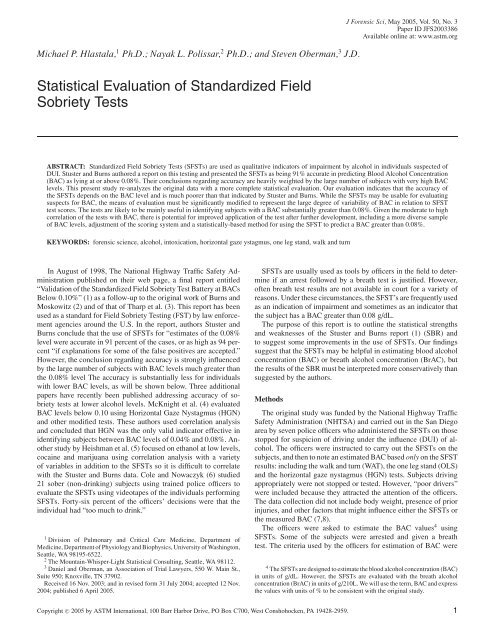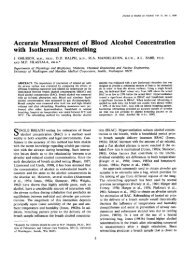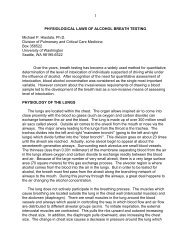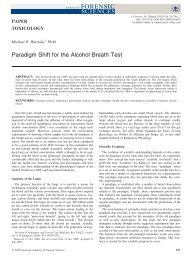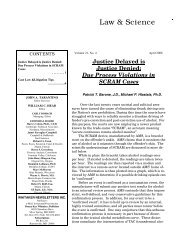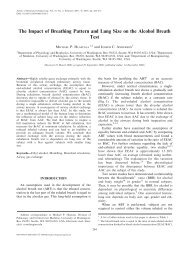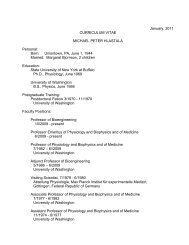Statistical Evaluation of Standardized Field Sobriety Tests
Statistical Evaluation of Standardized Field Sobriety Tests
Statistical Evaluation of Standardized Field Sobriety Tests
Create successful ePaper yourself
Turn your PDF publications into a flip-book with our unique Google optimized e-Paper software.
Michael P. Hlastala, 1 Ph.D.; Nayak L. Polissar, 2 Ph.D.; and Steven Oberman, 3 J.D.J Forensic Sci, May 2005, Vol. 50, No. 3Paper ID JFS2003386Available online at: www.astm.org<strong>Statistical</strong> <strong>Evaluation</strong> <strong>of</strong> <strong>Standardized</strong> <strong>Field</strong><strong>Sobriety</strong> <strong>Tests</strong>ABSTRACT: <strong>Standardized</strong> <strong>Field</strong> <strong>Sobriety</strong> <strong>Tests</strong> (SFSTs) are used as qualitative indicators <strong>of</strong> impairment by alcohol in individuals suspected <strong>of</strong>DUI. Stuster and Burns authored a report on this testing and presented the SFSTs as being 91% accurate in predicting Blood Alcohol Concentration(BAC) as lying at or above 0.08%. Their conclusions regarding accuracy are heavily weighted by the large number <strong>of</strong> subjects with very high BAClevels. This present study re-analyzes the original data with a more complete statistical evaluation. Our evaluation indicates that the accuracy <strong>of</strong>the SFSTs depends on the BAC level and is much poorer than that indicated by Stuster and Burns. While the SFSTs may be usable for evaluatingsuspects for BAC, the means <strong>of</strong> evaluation must be significantly modified to represent the large degree <strong>of</strong> variability <strong>of</strong> BAC in relation to SFSTtest scores. The tests are likely to be mainly useful in identifying subjects with a BAC substantially greater than 0.08%. Given the moderate to highcorrelation <strong>of</strong> the tests with BAC, there is potential for improved application <strong>of</strong> the test after further development, including a more diverse sample<strong>of</strong> BAC levels, adjustment <strong>of</strong> the scoring system and a statistically-based method for using the SFST to predict a BAC greater than 0.08%.KEYWORDS: forensic science, alcohol, intoxication, horizontal gaze ystagmus, one leg stand, walk and turnIn August <strong>of</strong> 1998, The National Highway Traffic Safety Administrationpublished on their web page, a final report entitled“Validation <strong>of</strong> the <strong>Standardized</strong> <strong>Field</strong> <strong>Sobriety</strong> Test Battery at BACsBelow 0.10%” (1) as a follow-up to the original work <strong>of</strong> Burns andMoskowitz (2) and <strong>of</strong> that <strong>of</strong> Tharp et al. (3). This report has beenused as a standard for <strong>Field</strong> <strong>Sobriety</strong> Testing (FST) by law enforcementagencies around the U.S. In the report, authors Stuster andBurns conclude that the use <strong>of</strong> SFSTs for “estimates <strong>of</strong> the 0.08%level were accurate in 91 percent <strong>of</strong> the cases, or as high as 94 percent“if explanations for some <strong>of</strong> the false positives are accepted.”However, the conclusion regarding accuracy is strongly influencedby the large number <strong>of</strong> subjects with BAC levels much greater thanthe 0.08% level The accuracy is substantially less for individualswith lower BAC levels, as will be shown below. Three additionalpapers have recently been published addressing accuracy <strong>of</strong> sobrietytests at lower alcohol levels. McKnight et al. (4) evaluatedBAC levels below 0.10 using Horizontal Gaze Nystagmus (HGN)and other modified tests. These authors used correlation analysisand concluded that HGN was the only valid indicator effective inidentifying subjects between BAC levels <strong>of</strong> 0.04% and 0.08%. Anotherstudy by Heishman et al. (5) focused on ethanol at low levels,cocaine and marijuana using correlation analysis with a variety<strong>of</strong> variables in addition to the SFSTs so it is difficult to correlatewith the Stuster and Burns data. Cole and Nowaczyk (6) studied21 sober (non-drinking) subjects using trained police <strong>of</strong>ficers toevaluate the SFSTs using videotapes <strong>of</strong> the individuals performingSFSTs. Forty-six percent <strong>of</strong> the <strong>of</strong>ficers’ decisions were that theindividual had “too much to drink.”1 Division <strong>of</strong> Pulmonary and Critical Care Medicine, Department <strong>of</strong>Medicine, Department <strong>of</strong> Physiology and Biophysics, University <strong>of</strong> Washington,Seattle, WA 98195-6522.2 The Mountain-Whisper-Light <strong>Statistical</strong> Consulting, Seattle, WA 98112.3 Daniel and Oberman, an Association <strong>of</strong> Trial Lawyers, 550 W. Main St.,Suite 950; Knoxville, TN 37902.Received 16 Nov. 2003; and in revised form 31 July 2004; accepted 12 Nov.2004; published 6 April 2005.SFSTs are usually used as tools by <strong>of</strong>ficers in the field to determineif an arrest followed by a breath test is justified. However,<strong>of</strong>ten breath test results are not available in court for a variety <strong>of</strong>reasons. Under these circumstances, the SFST’s are frequently usedas an indication <strong>of</strong> impairment and sometimes as an indicator thatthe subject has a BAC greater than 0.08 g/dL.The purpose <strong>of</strong> this report is to outline the statistical strengthsand weaknesses <strong>of</strong> the Stuster and Burns report (1) (SBR) andto suggest some improvements in the use <strong>of</strong> SFSTs. Our findingssuggest that the SFSTs may be helpful in estimating blood alcoholconcentration (BAC) or breath alcohol concentration (BrAC), butthe results <strong>of</strong> the SBR must be interpreted more conservatively thansuggested by the authors.MethodsThe original study was funded by the National Highway TrafficSafety Administration (NHTSA) and carried out in the San Diegoarea by seven police <strong>of</strong>ficers who administered the SFSTs on thosestopped for suspicion <strong>of</strong> driving under the influence (DUI) <strong>of</strong> alcohol.The <strong>of</strong>ficers were instructed to carry out the SFSTs on thesubjects, and then to note an estimated BAC based only on the SFSTresults: including the walk and turn (WAT), the one leg stand (OLS)and the horizontal gaze nystagmus (HGN) tests. Subjects drivingappropriately were not stopped or tested. However, “poor drivers”were included because they attracted the attention <strong>of</strong> the <strong>of</strong>ficers.The data collection did not include body weight, presence <strong>of</strong> priorinjuries, and other factors that might influence either the SFSTs orthe measured BAC (7,8).The <strong>of</strong>ficers were asked to estimate the BAC values 4 usingSFSTs. Some <strong>of</strong> the subjects were arrested and given a breathtest. The criteria used by the <strong>of</strong>ficers for estimation <strong>of</strong> BAC were4 The SFSTs are designed to estimate the blood alcohol concentration (BAC)in units <strong>of</strong> g/dL. However, the SFSTs are evaluated with the breath alcoholconcentration (BrAC) in units <strong>of</strong> g/210L. We will use the term, BAC and expressthe values with units <strong>of</strong> % to be consistent with the original study.Copyright C○ 2005 by ASTM International, 100 Barr Harbor Drive, PO Box C700, West Conshohocken, PA 19428-2959. 1
2 JOURNAL OF FORENSIC SCIENCESFIG. 1—Estimated BAC vs. Measured BAC for all subjects in the Stuster and Burns study. The line <strong>of</strong> identity (Estimated BAC = Measured BAC; thinline) and linear regression line (heavy solid line) are shown.not described in the report. There appears to be no specific quantitativecombination <strong>of</strong> the FSTs, but rather there appears to be asubjective estimate <strong>of</strong> BAC. In other words, the decision to determinean estimated BAC was left to the subjective judgment <strong>of</strong> each<strong>of</strong>ficer. Each set <strong>of</strong> FSTs (for a given subject) was scored by onlyone <strong>of</strong>ficer. So it was not possible to assess inter-<strong>of</strong>ficer variability.The data <strong>of</strong> Stuster and Burns were obtained via a request tothe National Highway and Transportation Safety Administration(NHTSA) using the Freedom <strong>of</strong> Information Act (FOIA). Fig. 1shows the raw data {estimated BAC (EBAC) vs. measured BAC(MBAC)} for 297 subjects, who had a mean EBAC and MBAC<strong>of</strong> 0.117% and 0.122%, respectively. The figure shows the line <strong>of</strong>identity (EBAC = MBAC) and a least-squares regression line forEBAC vs. MBAC. In some cases the EBAC was greater than theMBAC resulting in a greater probability <strong>of</strong> arrest than if the MBAChad been used (points above the line <strong>of</strong> identity). In other casesEBAC was lower than MBAC resulting in a lower probability <strong>of</strong> arrestthan if MBAC had been used (points below the line <strong>of</strong> identity).EBAC is plotted against MBAC for all observations. The MBAC<strong>of</strong> these points varies over a range <strong>of</strong> BAC = 0.00% to 0.33%.<strong>Statistical</strong> MethodsThe accuracy with which <strong>of</strong>ficers classified drivers as having aBAC above or below 0.08% is presented graphically by sortingthe data on increasing MBAC and then using a moving window<strong>of</strong> 21 observations, shifting upward one observation at a time. Theaccuracy is calculated as the percentage <strong>of</strong> observations in thewindow that are correctly classified as
HLASTALA ET AL. • FIELD SOBRIETY TESTS ACCURACY 3FIG. 2—Accuracy <strong>of</strong> classification <strong>of</strong> individuals as ≥0.08% or
4 JOURNAL OF FORENSIC SCIENCESFIG. 3—Measured breath alcohol concentration versus total <strong>of</strong> three test scores.FIG. 4—Percent <strong>of</strong> subjects with MBAC greater than 0.08% vs. the individual test score, with the percentage calculated for all individuals at or abovethe designated score.
HLASTALA ET AL. • FIELD SOBRIETY TESTS ACCURACY 5TABLE 1—Pearson correlation <strong>of</strong> three <strong>Field</strong> <strong>Sobriety</strong> <strong>Tests</strong> withmeasured breath alcohol (MBAC) and <strong>of</strong>ficer-estimated breathalcohol (EBAC).Test MBAC EBACTOTAL score (3 tests) 0.69 0.74HGN Horizontal Gaze Nystagmus 0.65 0.71WAT Walk and turn 0.61 0.64OLS One leg stand 0.45 0.51three individual test scores. For each score (horizontal axis), thepercent <strong>of</strong> subjects with that score or higher who have an MBAClarger than 0.08% is plotted (Y-axis). In order to observe 95% <strong>of</strong>persons with MBAC > 0.08% in this sample, the score for WAT(circles in the plot) must be 5 or larger. None <strong>of</strong> the scores for HGN(crosses) reach the 95% point and the scores for OLS (triangles)reach over the 95% point only at 10 points and higher, where thereare only two subjects. Note that the “failure” scores for these threetests, as specified by Stuster and Burns, are 4 for HGN, 2 for OLS,and 2 for WAT (12). Failure <strong>of</strong> an FST according to NHTSA standardssimply estimate the 50% likelihood that a subject is >0.08%.The data show that in order to be considerably more confidentthat the subject is above 0.08%, the scores should be much higherthan the “failure” scores.The correlation coefficients for individual tests vs. both MBACand EBAC are shown in Table 1. The FST with the strongest correlationwith MBAC is HGN followed by WAT and OLS. Thestrongest correlation is with the total test (determined by summingthe scores for the three FSTs. However, total score and HGN havevery similar correlations with MBAC and EBAC.DiscussionFigure 5, redrawn from Fig. 4 <strong>of</strong> SBR. illustrates the logic usedby Stuster and Burns to describe the accuracy <strong>of</strong> SFST. A correctdecision was registered if both MBAC and EBAC are ≥0.08%(upper, right quadrant; N + 210) or both are ≤0.08% (lower, leftquadrant; N = 59). An incorrect decision occurred with a falsepositive (upper, left quadrant; N = 24), when (EBAC ≥ 0.08% andMBAC < 0.08%) or a false negative (lower, right quadrant; N = 4),when EBAC < 0.08% and MBAC ≥ 0.08%. Because such a largefraction <strong>of</strong> the points were between 0.08% and 0.33% (N = 214<strong>of</strong> the 297 total points) and most <strong>of</strong> these had a MBAC > 0.12,Stuster and Burn’s conclusion that the tests have 91% accuracywas strongly affected by the fact that a majority <strong>of</strong> points are inthis high MBAC range, where correct classification as above 0.08is more reliable. Of the correct results, 210 data points out <strong>of</strong>a study total <strong>of</strong> 297 were in the 0.08% to 0.33% range and 59were in the 0.000% to 0.079% range. (The accuracy estimated byStuster and Burns as 91% was calculated from the values in Fig. 2as (210 + 59)/297 = 0.91). The number <strong>of</strong> false positives (N = 24)was much greater than the number <strong>of</strong> the false negatives (N = 4). Inthe range <strong>of</strong> data near the 0.08% level, the estimated BAC by theseexperienced <strong>of</strong>ficers overestimates the measured BAC, introducinga bias against the subjects (see Fig. 1). Using EBAC to determinewhether the subject MBAC is greater than 0.08% is 100% accuratefor all subjects with MBAC > 0.12%. In other words, if the subjectis highly intoxicated, the SFST provide an accurate indication. Itis not surprising that if the subject is clearly intoxicated, the <strong>of</strong>ficerscan make this determination. If the MBAC is
6 JOURNAL OF FORENSIC SCIENCESAn alternative way to explore the accuracy <strong>of</strong> SFST is to assessthe accuracy over a range <strong>of</strong> points that is symmetric about the0.08% cut-point (limit). In addition to accuracy, four traditionalstatistics <strong>of</strong> test performance also help in this exploration: sensitivity,specificity, positive predictive value and negative predictivevalue. Table 3 shows the accuracy <strong>of</strong> SFST when the range <strong>of</strong> interestextends above and below 0.08% by the same amount, along withthe four traditional performance statistics. For data with MBACranging between 0.07% and 0.09%, The SFST are 72.2% accurate.As the range broadens, the calculated apparent accuracy increases.At the broadest range <strong>of</strong> 0.04%–0.12%, the calculated apparent accuracyis now 82.2%. Taken to the extreme, using all <strong>of</strong> the datapoints (MBAC = 0.00% to 0.033%), the apparent accuracy is 91%as calculated by Stuster and Burns. The accuracy <strong>of</strong> SFST in thevicinity <strong>of</strong> 0.08% is poorer than estimated in the SBR for the wholedata set.TABLE 3—Accuracy and other statistics related to “over-limit”designation based on estimated breath alcohol concentration for definedranges <strong>of</strong> MBAC.Range <strong>of</strong> Total inMBAC Range Accuracy Sensitivity Specificity PPV NPV0.07–0.09 36 72% 96% 36% 70% 83%0.06–0.10 65 75% 95% 44% 73% 85%0.05–0.11 97 79% 97% 55% 75% 92%0.04–0.12 135 82% 95% 63% 79% 90%All cases 297 91% 98% 71% 90% 94%Accuracy = (# correctly classified as ≥0.08 or
HLASTALA ET AL. • FIELD SOBRIETY TESTS ACCURACY 70.10%, the EBAC values tend to underestimate the MBAC. Out <strong>of</strong>174 data points with MBAC >0.10%, 50 are overestimates and 108are underestimates <strong>of</strong> MBAC. Thus, the experienced <strong>of</strong>ficers usedin this study tended to overestimate the BAC at low levels (0.10).The optimal predictive capability <strong>of</strong> the SFST depends on thescaling for the particular test and the predictive capacity <strong>of</strong> the test.The maximum scores permitted for HGN, OLS and WAT are 6,4, and 8, respectively. However, some <strong>of</strong>ficers assigned scores thatwere greater than the maximum score allowable for a given FST.The highest scores assigned in this study were 6, 12, and 9 for theHGN, OLS and WAT, respectively.By adjusting the weight given to each test and taking account <strong>of</strong>the precision <strong>of</strong> the test in predicting MBAC, we find the followinglinear regression model (Eq 1) maximizes the precision <strong>of</strong> the SFSTfor estimating MBAC, using only linear versions <strong>of</strong> the three testvariables. The quadratic terms (squared values <strong>of</strong> the three test variables),while statistically significant as a group (p = 0.004) increaseR-squared by only 2%, from 54% to 56%, and have been omittedfor parsimony. The model is based on the 261 cases without anymissing values for the three tests. Note in the equation below thatthe increase in BAC per point increase in the score is largest forHGN, with a 0.017 increase in BAC, on the average, for each pointincrease in the HGN score.MBAC =−0.007 + 0.017 × (HGN Score) + 0.0012× (OLS Score) + 0.011 × (WAT Score) (1)The equation does quite well in predicting the mean MBAC,but there is still a large spread <strong>of</strong> individuals around the predictedvalue. The standard deviation <strong>of</strong> individual MBAC values aroundthe predicted regression value is 0.044%. A 95% confidence intervalfor the true MBAC <strong>of</strong> an individual, predicted from this regressionmodel, would have a minimum width <strong>of</strong> ±0.09%, certainly a widerange.Using the predictors (HGN, OLS, WAT), the additive model fromequation 1 accounted for 54% <strong>of</strong> the variability in MBAC (correspondingto a correlation <strong>of</strong> 0.73). Including EBAC as an additionalpredictor in the model resulted in a substantial and significant increase(p
8 JOURNAL OF FORENSIC SCIENCES9. Price P, Cole S. NHTSA field sobriety tests validation v. invalidation, 25The Champion. 2001;25:37–42.10. Fisher LD, van Belle G. Biostatistics. Wiley, 1993.11. Weisberg S. Applied linear regression, 2nd edition. Wiley,1985.12. NHTSA DWI Detection and <strong>Standardized</strong> <strong>Field</strong> <strong>Sobriety</strong> Testing StudentManual, DOT-HS-178-R1/02.Additional information and reprint requests:Michael P. Hlastala, Ph.D.Division <strong>of</strong> Pulmonary and Critical Care Medicine, Department <strong>of</strong> MedicineDepartment <strong>of</strong> Physiology and BiophysicsBox 356522University <strong>of</strong> WashingtonSeattle, WA 98195-6522E-mail: hlastala@u.washington.edu


